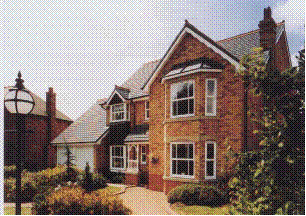Interiors: the importance of cosiness
The most desirable home :a detahed house
Notice:
• the 'traditional' building materials of brick (the walls) and slate (the roof); • the irregular , 'non-classical' , shape, with all those little corners, making the house feel 'cosy'; • the suggestion of a large front garden with a tree and bushes, evoking not only the countryside but also giving greater privacy • that the garage (on the left is hidden discretely away, so that it is not too obvious and doesn't spoil the rural feeling; • that the front door is not even in the picture (the privacy criterion at work again).

Second best: a semi-detached
Unless they are located in the remotest parts of the country detached houses are too expensive for most people. So this is what a very large proportion of people live in one building with two separate households. Notice: the separate front garden for each house. At the sides , there is access to the back, where there will also be two gardens. The most common building material is brick. The typical semi-detached has two floors and three bedrooms.

An exception: the town house
These houses , which can be found in the inner areas of most cities, are an exception to the general pattern. There is great variety regarding both design and use. Many have been broken up into flats or rooms for rent. Sometimes , these are 'self-contained' flats, sometimes, they are ' bedsits' (i.e. bed-sitting rooms ; residents have one room to themselves and share washing and cooking facilities with other residents)

Less desirable: a terraced house
Each house in the row is joined to the next one. (Houses at the end of the row are a bit more desirable - they are the most like a semi-detached). They usually have two floors, with two bedrooms upstairs. Some have gardens back and front , others only at the back and others no garden at all. Before the 1960s, Britain had millions of terraced houses, most with no inside toilet or bathroom.

The least desirable: a flat
Not having a separate entrance to the outside world does not suit British tastes. Although it is densely populated, Britain has the second lowest proportion of flat-dwellers in the EU (the lowest of all is in Ireland).

Interiors: the importance of cosiness
British houses have a reputation for being the coldest in Europe. Moreover, to many people from other countries, British people seem to be ridiculously keen on 'fresh air'. This reputation is exaggerated. It is partly the result of the fact that houses in Britain are, on average, older than they are in other countries and are not so well insulated. In fact, about three-quarters now have central heating. However, there is a grain of truth in it. Windows, for example, are designed so that they can be conveniently opened to a great variety of degrees – instead of as in many other countries, either being completely shut or fully open. This way, air can be let into the house in winter without freezing its inhabitants.
Just as the British idea of home is a mental concept as much as a physical reality, so is their idea of domestic comfort. The important thing is to feel cosy - that is, to create an atmosphere which seems warm even if it isn't really warm. This desire usually has priority over aesthetic concerns, which is why the British also have a reputation for bad taste.
To many, tradition is part of cosiness, and this can be suggested by being surrounded by old items of furniture. And if you cannot have furniture which is old, you can always have other things that suggest age. The open fire is an example. In Britain , it is regarded by many as very desirable to have a 'real fire ' (as it is often called). It is the perfect traditional symbol of warmth because it is what most people used in the past to keep warm. So strong is the attraction of a 'real fire' that many houses have an imitation open fire, complete with plastic coal which glows red when it is switche d on. Bad taste? So what!
Most older houses, even very small ones, have not one but two general living rooms (which estate agents call 'reception rooms ').This arrangement maintains privacy (which is linked to cosiness). It allows the front room to be kept for comparatively formal visits, while family members and close friends can spend their time, safely hidden from public view, in the back room. The same concern can be seen where there is both a front door and a back door. Even if both can be reached from the street, the back door is for family and close friends only.